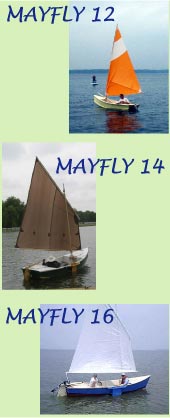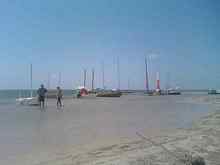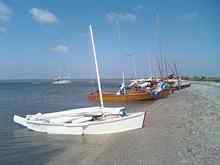
 Custom Search
|
|
| sails |
| plans |
| epoxy |
| rope/line |
| hardware |
| canoe/Kayak |
| sailmaking |
| materials |
| models |
| media |
| tools |
| gear |
 |
 |
| join |
| home |
| indexes |
| classifieds |
| calendar |
| archives |
| about |
| links |
| Join Duckworks Get free newsletter Comment on articles CLICK HERE |
|
|
| Gamaray, a Mayfly 14, Does the Texas200 - Pt 3 |
by Chuck Pierce - Beaumont, Texas - USA |
Michalak Mayfly: Part 1 - The Build As soon as I had the tent set up at Camp 2, Stan’s son Josh helped me carry tools and the rudder up to the tent and held the rudder steady as I drilled and through-bolted the pintles with some 1/4'” stainless bolts and nyloc nuts (which is what I should have done in the FIRST place!). I have built rudders for larger boats and always used bolts instead of screws, but I really did not think that such a small blade on such a small boat would generate enough force to rip out 1” #10 screws. My mistake. The quartering waves from astern that are present during a good part of this trip make it necessary to be very active in terms of steering, and that puts lots of sideways force on the rudder. Through bolt everything on a rudder, even if it’s on a PDR! Heading into Baffin Bay, that pesky green skiff zoomed by us again-those guys were always in a hurry! Both John and Mik are competitive by nature and they are both very good sailors. Gir was about the fastest boat in the fleet this year. Gamaray had both reefs in by this time and they stayed in for the remainder of the trip. Even with both reefs in, our speed averaged 5 to 6 knots. There were times when the wind would kick up even higher and at those times we would hit 7 knots for a few minutes. The highest speeds we saw were on the 5th and 6th days when we averaged 6 or 7 knots, and hit 8 a few times. I think the boat was starting to lighten up a bit as water and food supplies were consumed. In a boat with a 12 foot waterline these speeds are plenty fast as far as I am concerned (course my main cruising boat is a Potter 19 so it’s not like I am used to going fast to begin with). Another thing-if you are singlehanding on this trip you really have to pace yourself. We were on the water 8 to 10 hours a day and taking a break meant pulling over and anchoring (in mostly rough water) or beaching the boat. In these winds, trying to squeeze out every bit of performance is hard on the boat and on the sailor, too, and sailing the boat on the edge all day takes a somewhat difficult, fun adventure and turns it into an ordeal for the singlehander. You want to take it easy if you are singlehanding, in my opinion anyway. The camp routine ran like this-after beaching the boat, I would dig out the 18” spiral ground stake (made for a dog tethering system, I believe) with its 50 foot line, and screw the stake into the sand until only the ring showed. It held very well and I could not pull it out unless I pulled straight up on it. This left the anchor to be used at the stern to keep Gamaray from swinging into neighboring boats as the tide came in and she started to float. After the boat was secured, the front hatch would be opened and (to the amazement of those in other boats with less storage capacity) I would pull out the tent, ground tarp, air mattress, foot pump, a 5 gallon bucket with the stove and cooking stuff in it, sleeping bag, full sized pillow, and camp clothes bag. Someone (apparently jealous of the luxuries to be found in the storage compartment of a 14 foot boat) commented that it was like watching the old video clip where an unending stream of people keep piling out of a Volkswagen Beetle. The ground tarp, tent, air mattress, and foot pump went ashore first. After finding a suitable place to pitch the tent, the ground tarp went down, the tent was set up, and the mattress was unrolled inside and pumped up. I was able to get everything else in one more trip down to the boat. After dumping it all inside the tent (being careful not to let any of the dreaded sand in there), I would strip off my boat clothes down to the bathing suit I wore under them, grab the Ivory liquid soap, and head back to the water. Ivory liquid is perfect for boat trips because you can use it to wash dishes, clothes, or yourself, and it lathers in salt water. A quick lather and dunk, and I would stop by the boat on the way back to the tent to pick up one of the greatest contributions to the small boating world EVER, The Amazing Duckworks Solar Pump-Up Shower. This thing is Chuck Leinweber’s alternative to the hanging bag POS solar showers that the sporting goods stores sell. If you’ve ever used one of these “showers” you have experienced the dreaded cap/hose failure wherein the cap or hose falls off in use and you are subjected to a 3 second deluge whether you are ready for it or not, followed by the realization that there will be no more showers for the rest of the trip because the last of your shower water just went down the cockpit drain. It took only a few cups of water per day to wash the salt off of me with the fine shower head that comes with the Pump-Up Shower, so after filling it up in Port Isabel, it did not run out of water until the last shower I took with it after making landfall at Seadrift. A few years ago I was on the Watertribe website and read through Steve Isaacs’ dissertation on required equipment for the Everglades Challenge. I learned a lot from that document, but my favorite concept was that of camp clothes. On this trip I had 2 sets of boat clothes and 3 sets of camp clothes. The camp clothes (and shoes) were put on after my shower each evening and having dry clean clothes to rest and sleep in made a huge difference in how well rested I was each morning. One set of boat clothes were used for the first 3 days, the other for the last 3. I would rinse them and hang them on the outside of the tent to dry each evening and by morning they would be barely damp until we hit the water at which time they would again become soaked in no time flat.
At this point in the day most of us would disappear into tents or other shade – developing devices for an hour or two out of the sun. The sun is the biggest enemy of the small boat sailor down here and should be taken VERY seriously. How bad is it? Well, after three days on the water in a small open boat (and in spite of my wide brimmed sailing hat) my shoulders were getting sunburned through my SPF 50 shirt. On succeeding days I lathered on sunscreen before putting my boat clothes on and that helped. The next morning we once again headed up the ICW. The first 3 days of the trip were pretty simple in terms of navigation. Sail out to the ICW, turn north, follow the cans until you see a bunch of sailboats pulled up somewhere, and sail onto the beach next to them. Today we would break free of the constraints of the ICW and head into the bays. First, though, I had to stop at the Marker 37 Marina for a special treat of a honeybun and a couple of bottles of cold water. Some of the Texas200 boats had stopped at Snoopy’s next door for lunch, and just about everyone stopped by the marina to stock up on water and anything else they were running short on. Heading down the ICW, we noticed the Folding Schooner pulled up on a spoil island on the port side of the channel. They indicated that they were okay and a few minutes later blasted past us. That thing is a 32 foot rocket ship! We turned out of the ICW into Corpus Christi Bay just before GC7. Winds were high (20 knots by noon), and the bay was rough, so we tacked down to within a quarter mile of Mustang Island and took advantage of the somewhat smoother water in the lee of the island. We had passed Ozey Pearl, the nicely built Pelican sailed by Frank Coletta and Bruce Grundy, earlier in the day while still in the ICW. By the time we turned northeast for our run through Shamrock Cove they had appeared behind us again. Those guys are veterans of the 200, and in spite of the rough waters and high winds they did well coming across the Bay. As we passed through Shamrock Cove I noticed a Coast Guard cutter on station about a mile ahead of us. We passed within 200 yards of it and although I could see a couple of guys checking us out with binoculars, they never tried to call us on the radio or hail us. The ride across the Bay was rough and at times a bit tense, so after threading Stingray Hole and turning east into the Ship Channel I wanted a break and the chance to have something for lunch that didn’t start with Clif and end with Bar. One of the great things about the Mayfly is that the weighted rudderblade and the auto release camcleat on the leeboard allow the boat to take care of itself when beaching. I can find a beach and sail up to it and not worry about a thing but steering and working the sheet. Point of Mustang on the south side of the channel had a beach that looked like it fit the bill, so I headed over for a quick lunch and the opportunity to stretch my legs. I saw Ozey Pearl pass and within about 5 minutes of my arrival, a large catamaran (30’ ?) with some sunbathers in bikinis whose crew had seen me sail up to the beach tried the same trick and grounded hard about a hundred yards out. I had some pretty good entertainment for the first 15 minutes of my lunch, although the language I could hear would not have passed muster on TV anywhere but HBO. They eventually got the sails down, started the engine and were able to back into the channel, then took off to the west as I raised sail and headed east towards Port Aransas. In 2010 we had spent a couple of hours tacking up the Corpus Christi Channel after the wind went more to the east than is normal. This year it blew out of the southeast like it is supposed to, and the trip past the ferries at Port Aransas was fast and all on one tack! The rest of the sail was easy and quick-we pulled up at Camp 4 about 3pm. It was a nice sand/shell beach not far from the entrance to Corpus Christi Bayou.
The next morning we were off at dawn. Today there would be not only the challenge of dealing with the small craft advisories NOAA was predicting, but some pretty interesting navigational and equipment challenges. Stan and Josh (in Spartan, Stan’s Michalak Family Skiff) pulled out of camp shortly after we did and caught up with us as we sailed past the western tip of Mud Island. It was choppy and the winds were already at 17 or 18 knots, and I had my hands pretty full between sailing the boat and watching a small tear in the luff of Gamaray’s polytarp sail get larger. I did not get any pictures of them which was a shame, because they were the last boat I saw until I made camp that evening. As they disappeared into the distance, I looked for a good spot on Mud Island to pull over and do some repair work. A couple of miles down, maybe half a mile from the eastern tip of the island, there was a nice beach that the chart said was hard sand. We pulled in and found that the chart was accurate on that point. The beach sloped up to a small ridge maybe 6 feet above sea level, then back down to the other side of the island which is separated from San Jose Island by a narrow channel. I had done some retaping on the luff of the sail on Wednesday, but that tape had started to come off after just 2 days, and today I was having trouble getting tape to stick at all to the damp, salt covered tarp where it was pulling away from the rope that was taped into the luff seam. After thinking it over for a few minutes, I opened the rear hatch and pulled out the grommet box, a small piece of scrap tarp material, and a short piece of scrap ¼” line along with the sewing supplies and palm. A couple of inches inboard of the tear I sewed 2 reinforcing patches separated by about 6 inches, then put a grommet through each and tied a piece of line through each grommet and around the reinforcing rope that ran all of the way around the sail. A half hour after we had pulled up on the beach, I raised the sail and inspected it. It looked as if it would hold up okay, and in fact gave us no further trouble. There is a lesson here-don’t build a new taped polytarp sail from a previously used sail/tarp. The tape does not seem to stick as well, although I must say that this sail had 40 or 50 hours on it in winds over 20 knots before we ever got down to Port Isabel, so I don’t know for sure that the used polytarp had anything to do with it. I know of 2 polytarp sails that were sewn and that blew out completely on this years’ trip. Sewn polytarp is without a doubt sturdier than taped polytarp-it may be that this was just a tough year in terms of wind. We left the beach and sailed on towards Paul’s Mott Reef. |


